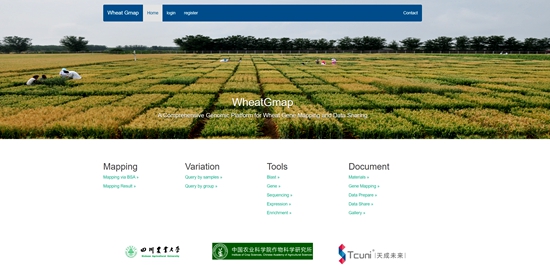WheatGmap: A Comprehensive Platform for Wheat Gene Mapping and Genomic Studies
Recently, researchers from Institute of Crop Sciences, Chinese Academy of Agricultural Sciences, together with their collaborators from Sichuan Agricultural University and Tcuni Inc. developed WheatGmap (https://www.wheatgmap.org), a web-based bulked segregant analysis (BSA) platform that integrates multiple BSA mapping models and numerous public data to accelerate gene cloning and functional research and facilitate resource sharing. The results were published online in Molecular Plant entitled “WheatGmap: A Comprehensive Platform for Wheat Gene Mapping and Genomic Studies”.
BSA is an efficient and low-cost strategy that is widely used to identify causal genes in segregating populations. However, for researchers lacking a strong bioinformatics background, analyzing of high-throughput sequencing data, optimizing correct algorithm, and integrating the published data are big challenges to rapid map and screen candidate genes. Therefore, the new professional data processing platform with a user-friendly interface will be of great significance in promoting wheat researches.
The current version of WheatGmap contains more than 3,500 next-generation sequencing datasets of hexaploid wheat, including whole-genome sequencing (WGS), whole-exome sequencing (WES), and RNA-sequencing (RNA-seq) datasets. To help researchers use these numerous resources for gene mapping, several BSA models, including the SNP index, Euclidean distance (ED), QTLseqr for quantitative trait loci (QTLs), and varBScore, have been integrated into the platform. Also, the platform integrates the Basic Local Alignment Search Tool (BLAST), gene annotation, expression analysis, gene ontology enrichment analysis, and other research tools. A typical workflow of population construction, online data analysis, and candidate gene screening for BSA performed on WheatGmap is illustrated with the use published data on the wheat yellow-green leaf mutant ygl1.
WheatGmap provides wheat researchers an easy-to-use platform for wheat gene mapping and genomic studies. The platform integrates multiple models for BSA-based gene mapping and a large amount of data to facilitate the use of BSA-based gene mapping, cloning and functional research in wheat, as well as the sharing of sequencing and phenotypic data. At the same time, with the advent of the pangenomic era, the platform will be constantly updated in the future to make it more powerful.

Composition and functions of WheatGmap
This work was supported by the National Key Research and Development Program of China, the National Transgenic Research Project of China, the Talent Program and Innovation Program of Chinese Academy of Agricultural Sciences (CAAS), the Tianshan Innovation Team Plan, and the National Natural Science Foundation of China. Thanks should be given to Lu Zefu (Institute of Crop Sciences, CAAS) and Gu Yongqiang (USDA-ARS Western Regional Research Center) for providing important comments on the manuscript.
More details can be found at the link below:
http://doi.org/10.1016/j.molp.2020.11.018
By Zhang Lichao (zhanglichao@caas.cn)
-
 Apr 18, 2024Opening Ceremony of the Training Workshop on Wheat Head Scab Resistance Breeding and Pest Control in Africa Held in CAAS
Apr 18, 2024Opening Ceremony of the Training Workshop on Wheat Head Scab Resistance Breeding and Pest Control in Africa Held in CAAS -
 Apr 03, 2024IPPCAAS Co-organized the Training Workshop on Management and Application of Biopesticides in Nepal
Apr 03, 2024IPPCAAS Co-organized the Training Workshop on Management and Application of Biopesticides in Nepal -
 Mar 28, 2024Delegation from the School of Agriculture and Food Science of University College Dublin, Ireland Visit to IAS, CAAS
Mar 28, 2024Delegation from the School of Agriculture and Food Science of University College Dublin, Ireland Visit to IAS, CAAS -
 Mar 25, 2024Director of World Food Prize Foundation visited GSCAAS
Mar 25, 2024Director of World Food Prize Foundation visited GSCAAS -
 Mar 20, 2024Institute of Crop Sciences (ICS) and Syngenta Group Global Seeds Advance Collaborative Research in the Seed Industry
Mar 20, 2024Institute of Crop Sciences (ICS) and Syngenta Group Global Seeds Advance Collaborative Research in the Seed Industry
